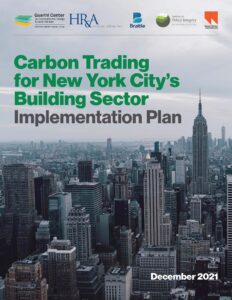Between January 2020 and June 2021, the Guarini Center led a team of researchers to study whether New York City should adopt a carbon trading program for its buildings pursuant to its landmark climate law, Local Law 97 of 2019. The study, which was the first rigorous assessment of Local Law 97, brought together researchers from various centers across New York University, including the Furman Center, Marron Institute, and Institute for Policy Integrity, as well as several private sector consultancies including The Brattle Group and HR&A Advisors.
This plan identifies key steps that the City would need to take to add a trading program as another compliance mechanism to Local Law 97 (LL97). Based on direction from the Mayor’s Office of Climate and Sustainability, the plan focuses on decisions the City would need to make to implement the first illustrative market design proposal that is described in the accompanying Carbon Trading Study Report.
Part I describes the different categories of tasks involved in implementing a trading program. Part I also provides brief case studies of the implementation of other precedent trading programs and recommends which functions the City should undertake itself and which it should outsource to third parties.
Part II identifies key issues that the City must address in rules about how the market will operate. It describes the rules that the City would need to establish to govern the initial allocation of credits, who could buy and sell credits in a trading program, and how trades would occur in the market. It also recommends steps that the City should take to prevent fraud and market manipulation, continue to center environmental justice in the implementation of the trading program, facilitate the disclosure of information to promote the development of a secondary market and to enable the public to assess the impacts of a trading program, and promote compliance.
Part III addresses several additional components of implementing a trading program. It discusses the timeline for implementing a trading program, the need for periodic review of the trading program, and strategies for stakeholder outreach about a trading program. This part also discusses what sort of budget would be needed to implement the program. A separate memorandum covers various important legal processes that the City should follow for implementation.
